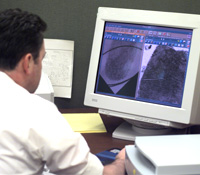PROTECTING
AMERICA FROM TERRORIST ATTACK
War Zones Link to FBI’s Fingerprint Database
06/27/05
 When the U.S. military
rounded up suspected terrorists in a raid in Iraq early last year, they
booked and fingerprinted them using the same tools police in the U.S.
use to check criminal backgrounds. The prints were logged, digitized,
and sent through a secure network to the FBI’s massive fingerprint
database in rural West Virginia, where they were added and compared to
more than 49 million sets of prints already on file.
When the U.S. military
rounded up suspected terrorists in a raid in Iraq early last year, they
booked and fingerprinted them using the same tools police in the U.S.
use to check criminal backgrounds. The prints were logged, digitized,
and sent through a secure network to the FBI’s massive fingerprint
database in rural West Virginia, where they were added and compared to
more than 49 million sets of prints already on file.
By sending the prints
to our Integrated Automated Fingerprint
Identification System (IAFIS), soldiers could find out within two
hours if any detainees had criminal histories in the U.S. They were also
seeding a growing biometric database of suspected terrorists, making
it harder for suspects to deny their identities or try to change them.
Now if any of the
suspects try to enter the U.S., they will be flagged.
Of the suspects in
the round-up in Iraq, 44 had criminal records in the U.S.; two were sought
on federal warrants.
“Does that make
America sleep better? Well, it should,” said David Shepard, an
FBI supervisory special agent who helped link the Department of Defense
to our Criminal Justice Information
Services (CJIS) Division, home to IAFIS. Dozens of FBI agents and
support personnel spent several years building the biometric link between
the Bureau and the military.
Based in part on the
success of efforts to plug the military into our fingerprint database,
the DoD last summer created its own biometric database, the Automated
Biometric Identification System (ABIS), which is modeled on IAFIS. Prints
sent to ABIS are also sifted through IAFIS, where they are screened for “priors” and
compared to the FBI’s most-wanted terrorists list.
“We resisted
the … tendency to ‘reinvent the wheel,’” John
D. Woodward Jr., director of the Department of Defense Biometrics Management
Office, said recently during a presentation on ABIS. “IAFIS is
a perfectly good wheel.”
The military’s
efforts followed Army Assistant Secretary John P. Stenbit’s 2003
directive that all new fingerprints be collected on FBI-approved equipment
and conform to the widely-accepted standards.
Before ABIS, the FBI
deployed fingerprint specialists to war zones, where they collected prints
on suspected terrorists. Now deployments are much less necessary.
The value of screening
fingerprints through the FBI’s database has been demonstrated several
times when suspects were detained after their fingerprints showed they
had been arrested before. In one case, suspected al Qaeda terrorist Mohamad
al Kahtani was positively identified when he was taken into custody at
Guantanamo Bay based on prints taken when he was denied entry to the
U.S. in August 2001.
“It’s
the classic recidivism,” Shepard said, referring to the repeat
offenders. “It’s pretty standard stuff that happens thousands
of times a day in America.”
DoD’s Woodward
also referenced the FBI’s success in linking criminals to their
pasts during his recent presentation on how biometrics will help soldiers
in the field: “IAFIS makes it very difficult for someone with a
criminal record to successfully say, ‘Officer, it’s a terrible
mistake. I’ve never been in trouble with the law before.’”
Links: Integrated
Automated Fingerprint Identification System | More
fingerprint stories | More
counterterrorism stories


